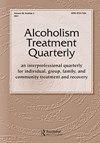Implementation of Screening, Brief Intervention, and Referral to Treatment (SBIRT) Training in Large Cohorts of Second Year Medical Students
IF 0.9
Q4 SUBSTANCE ABUSE
引用次数: 0
Abstract
ABSTRACT Substance use disorders are debilitating disorders with far reaching effects. However, many healthcare providers do not receive sufficient training on how to identify or respond to individuals who are at risk for SUDs. Because of this, residents of rural communities, who are served by fewer healthcare providers, are unlikely to encounter providers who are trained to respond effectively to SUDs. SBIRT is a tool used to intervene among patients engaging in risky substance use. Although numerous SBIRT training programs exist across the country, most have focused on relatively small groups of trainees, and have prioritized the training of mental health professionals. In response to this finding, we implemented a large-scale SBIRT training program designed to prepare approximately 540 medical students to meet the needs of patients at risk for or suffering from SUDs in West Texas. In this paper, we focused on medical student perceptions of the quality and utility of our SBIRT educational initiative. Student evaluations of the SBIRT training remained high across three cohorts of second-year medical students. The goal of this report is to provide recommendations to help enable any group to develop, adapt, and implement large-scale SBIRT training programs in other locations.筛查、短暂干预和转诊治疗(SBIRT)培训在大二医学生群体中的实施
摘要物质使用障碍是一种影响深远的衰弱性疾病。然而,许多医疗保健提供者没有接受足够的培训,了解如何识别或应对有SUDs风险的个人。正因为如此,由较少的医疗保健提供者提供服务的农村社区居民不太可能遇到受过有效应对SUD培训的提供者。SBIRT是一种用于干预高危药物使用患者的工具。尽管全国各地都有许多SBIRT培训项目,但大多数项目都侧重于相对较小的受训群体,并优先培训心理健康专业人员。针对这一发现,我们实施了一项大规模的SBIRT培训计划,旨在为大约540名医学生做好准备,以满足德克萨斯州西部有SUD风险或患有SUD的患者的需求。在本文中,我们重点关注医学生对SBIRT教育计划的质量和效用的看法。在三组医学二年级学生中,学生对SBIRT培训的评价仍然很高。本报告的目标是提供建议,以帮助任何团队在其他地点制定、调整和实施大规模SBIRT培训计划。
本文章由计算机程序翻译,如有差异,请以英文原文为准。
求助全文
约1分钟内获得全文
求助全文
来源期刊

Alcoholism Treatment Quarterly
SUBSTANCE ABUSE-
CiteScore
1.60
自引率
11.10%
发文量
31
期刊介绍:
Alcoholism Treatment Quarterly is an exciting professional journal for clinicians working with persons who are alcoholic and their families. Designed to bridge the gap between research journals and information for the general public, it addresses the specific concerns of professional alcoholism counselors, social workers, psychologists, physicians, clergy, nurses, employee assistance professionals, and others who provide direct services to persons who are alcoholic. The journal features articles specifically related to the treatment of alcoholism, highlighting new and innovative approaches to care, describing clinical problems and solutions, and detailing practical, unique approaches to intervention and therapy.
 求助内容:
求助内容: 应助结果提醒方式:
应助结果提醒方式:


